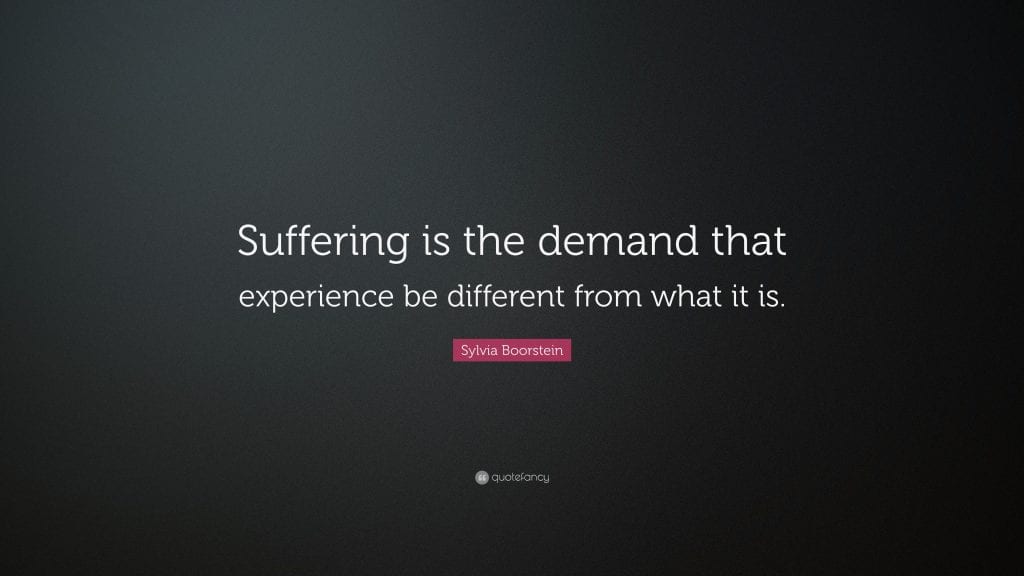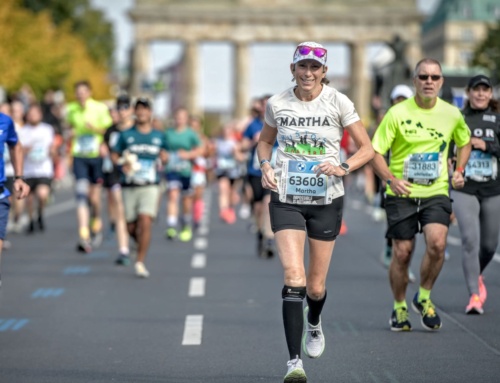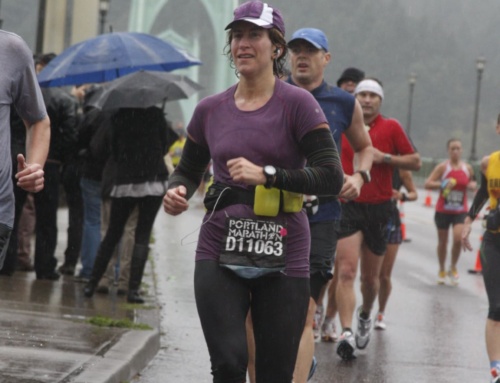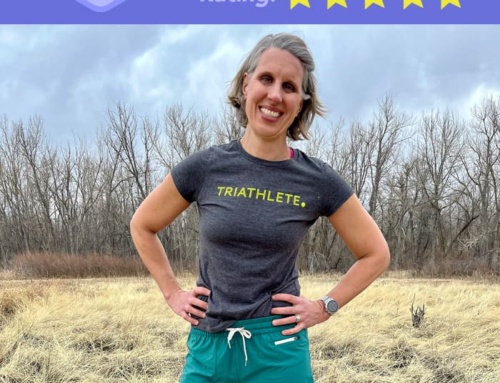
When you last heard from me on this blog in early April, I was managing gracefully. I’d like to think I still am. But when I wrote nearly two months ago, I was kind of hoping I’d be running a tiny bit by now. I’m not—and I don’t see it happening anytime in the next month or two.
My injury has been diagnosed as everything from a high hamstring strain to sciatica to a pinched nerve. These days, I’m describing it like somebody spilled coffee my spinal motherboard, and my muscles and nerves don’t know how to function or fire correctly, let alone support each other. The hamstring sounded the alarm, but it’s far from the only issue. My back and hips are totally in the mix, and it’s a mess.
I’ve bounced around to a few PT’s (all helpful in different ways, showing me different perspectives on my alignment and physiology); I’ve been dry-needled and cupped; I’ve heated and I’ve iced; I’ve rested and stretched and done enough glute bridges to qualify me for the Buns of Steel medal.
While I’ve had streaks of good days, I still haven’t found significant enough relief and progress to lead me to believe that going for a run wouldn’t set me back quite a bit.
With that in mind, I wanted to share a few things that I’ve learned over the past few months. I’m hoping you’re not injured, but if you are, I’m hoping they’ll help you too:
1. Change your perspective from Not Running to Healing.
For months, all I’ve thought about is the fact that I’m Not Running. I’m swimming three or four days a week, walking the other days, doing physical therapy or Pilates most days as well. Sounds like a lot—and it is, time-wise—but mostly, I think of myself as Not Running.
Any guesses on how well that’s Not Running mindset is going for me? Yep, not great. As Dr. Justin Ross says in the Perform Like a Mother sessions, your mind is like a spotlight: it focuses on whatever you choose to shine it on. I’ve had the klieg lights on Not Running.
So I’m trying to switch things. I’m not Not Running. I’m Healing. And my only goal with Healing: Feeling less pain today than I did yesterday. I just need to do that.
2. Acknowledge the pain.
Running injuries feel minor in the world of cancer and big disease that it can feel ridiculous to complain about them sometimes. “Oh, you were just diagnosed with breast cancer? And your mom has MS? Well, I’ve got this hamstring thing that has been going on since October, and I haven’t really run in about six months.”
Yeah, not so much.
And it also feels like I—an athlete for decades—should be able to just bear down and handle it. It’s not debilitating. I can still brush my teeth and send emails and otherwise get through the day as a 45-year-old functioning woman.
Thing is, chronic pain doesn’t have to be debilitating to be all encompassing. On bad days, it gnaws at me, wearing away patience and compassion for those I love the most, a fact that also gnaws at me. On good days, I am anxious about the pain coming back, and the vicious cycle starting again.
I recently tried an integrated Feldenkrais session, a practice that helps restore your body to its natural movement patterns. About halfway through my first session, the practitioner put her hands on my left shoulder and said, “You are in so much pain.” Her statement felt oddly validating. A running injury may not be life-threatening, but it’s certainly exhausting.
3. Then manage the pain physically.
Earlier this spring, I went to my orthopedic doctor, and he gave me a prescription for what, I later learned via google, is like advanced ibuprofen with arthritis relief. Arthritis? My grandmother had that in her knuckles. My ego doesn’t like that. But my back does.
Whether it’s a heating pad or a prescription or essential oils or turmeric or energy work, do what you need to do to get the pain to a manageable point. There will always be people who are anti-NSAIDS or anti-cortisone shots and preach, quite vocally, about the side effects of them. Weigh all your choices and listen to different opinions, then do what feels right for you.
Bottom line: You need to find some physical relief to let the healing begin. I kept wishing my pain away. Turns out, that isn’t super effective.
4. Tune in.
What exercises/techniques/practices actually relieve your pain vs. what should, based on anecdotal or other evidence, relieve your pain?
In other words, does dry-needling actually make you feel better or do you think it makes you feel better because it worked for your BRF or on a different area of your body?
This is a hard one and I’m all for the placebo effect, but so much of healing comes in shades of gray. I feel better in this position but not in this one; my back was a four on a scale of 1-10 yesterday, but now it’s a six. Why? Chronic injuries are not like broken bones that just heal with time and space; they are influenced by myriad factors.
That said, it seems reasonable that one should feel some significant relief within a handful of sessions. My chiropractor was instrumental in helping my shoulder when I was training for Ironman, but when I went to her this winter with my situation, her therapies weren’t working.
On the flip side, 50 clam shells with a band around my knees and 40 glute bridges with a band around my knees always provides relief.
5. And manage it mentally.
Easier said than done, as anybody who has been sidelined for extended periods of times knows. Here’s what has been working for me: emphasizing sleep, working in my garden, making sure I’m eating relatively well, checking out books at the library that have nothing to do with running, meditating for 10 minutes a day, then hanging with Sylvia Boorstein or Pema Chodron for another 10 minutes.
Today, Sylvia reminded me that, pain is inevitable, but, “suffering is the demand that something be different than what it really is.”
I cause myself to suffer when I set arbitrary dates on when I’ll be running again. I cause myself to suffer when I think about what I should have done differently to avoid the injury. I’m healing now. I will run again one day, but that day is not today, and it’s likely not tomorrow or three weeks from now. That’s ok.
6. Be kind to runners.
This doesn’t mean I’m advocating standing at the starting line of the half-marathon you can’t run, but jealousy and envy aren’t exactly healing emotions.
If I see a runner as I drive back from a swim, I do my best to think, “I hope you are having a good run and feeling strong.” (Or if I’m feeling really noble and am channeling Sylvia, I think, “May you live well and be well.”)
7. Don’t compare your cross-training and/or physical therapy to running. Spoiler alert: It won’t measure up.
Whether you genuinely love your miles or just love how you feel after your miles, running is the gold standard: super accessible; relatively affordable; a calorie torcher; good catch-up time with friends and/or podcasts/music; fresh air in spades. It’s all there.
Everything else has some kind of drawback. The dude next you at the gym on the elliptical is picking is nose. Swimming leaves your skin lizard dry. Squats on the BOSU in your laundry room? No fresh air for miles.
If you’re constantly complaining about what you actually can do and lamenting what you can’t do, you’re wasting energy. Of course I’d rather be running than swimming, but that’s not my reality right now. (Or as Sylvia says, it’s not what I wanted, but it’s what I got.) I can swim, I can walk for an hour, I can clamshell and TVA march and plank with the best of them. #goodenough
8. Chronicle your progress.
It’s super easy (and emotionally, very fulfilling) to throw up a run on Strava or in Training Peaks, but how satisfying is it to document a 15 minute session on the elliptical? Not very. Still, I’d argue that documenting your situation, both in terms of exercise and pain, is super important for two reasons:
—First, you have a record of what you did. That nebulous did-that-help-or-hurt? mentality becomes a little easier to clear up when you notice that you did side planks on Tu and Th, and on Wed and Fri your left shoulder ached more than usual.
—Second, you’re keeping yourself accountable. It can be crazy hard to keep up the momentum when you’re improving by centimeters, not meters, and filling in a chart is (and putting your workouts on social media, if you’re so incline) gives you a gentle push.
(Full disclosure: I haven’t been super good at this lately, but I’m going to get better again. Feel free to cheer for my swims on Strava!)
9. Cry. Totally fine to let your waterworks open again and again. Running is an integral part of my identity—and if you’ve read this far, it’s part of your’s too. Missing that slice of your life is going to hurt, and not acknowledging the absence hurts even more.







In early April my left knee started acting up. I got new shoes, started stretching after every workout, went to a chiropractor for ART and with little results found myself at the orthopedic for the first time in my running career. Last Thursday I had surgery to repair my meniscus. I am healing. My goal on my Garmin is to have few steps not more. I’m rocking my PT and execrises like a rock star. I finished one book and started another people are asking when I’ll run again. I know I will but I’m in no rush. I was very concerned about my mental health and not being able to have a good sweat session but I’m handling it all ok. Your blog post came at the perfect time Dimity.
This is all so accurate. I have spent months and months “wishing the pain awat.” I would add – try something new to see if it helps. I get stuck in not only wishing the pain away, but wishing that the same solutions will help or I just keep adding exercises on top of exercises taking more time and energy. Just this week I finally reached a point where I said – I am going to stop doing that exercise and be ok with it because it is not helping. Also so true about throwing out the rules on things like injections. Reducing the pain is key to mentally wrapping your mind around things.
Dimity, I am so sorry you are still on the injured reserve on the running team. I love the coping strategies you have outlined. I am confident you will heal soon. As a “one more thing to try”, there is this really cool lab at UVA called the SPEED Clinic. They do a 3D gait analysis. Because I am for the first time in a long time, feeling injury free, I wanted to try to stay this way and therefore went in for this analysis. They were able to find issues with my running gait that make me prone to injury and gave me drills to work on these things. You should check it out. You could stay with me if you want. I see a potential podcast in the future on this.
https://med.virginia.edu/speed-clinic/
I’m so sorry that you’re going through this. You are one of the strongest women I’ve met, and the perspective you gave in this post is amazing. I don’t do Strava, but if I did, I’d be cheering like a wild woman for your swims. I can’t swim a stroke, in spite of having tried to learn numerous times. You’re a rock start in the pool, and I’m sure what you can’t do on the roads right now, you’re definitely making up for in the water!
Thank you for this post Dimity. I’m not injured, but am three months postpartum following a difficult pregnancy during which I couldn’t exercise. I am so frustrated! By have no to take things slowly, by not feeling or looking the way I did a year ago. This was a great reminder that taking care of myself and healing (inevitably gradually) is all I can do at the moment, and far more important than whether I’ll be ready for my goal race. So glad I read this.
Dimity- Thanks for this amazing post. I am so sorry to read that you continue to be in pain and unable to run. When I posted on the TLAM page a few weeks ago that I knew people are going through bigger issues in relation to my post about my injury, of course I was thinking – it’s not cancer. I almost cried when MK responded – this ain’t the Hunger Games, we’re not judging pain. I admire your ability to do other things. I have spent the past month thinking – next week I’ll join a gym with a pool. Not moving is making me very cranky and not helping my hip which seems to hurt less after moving. One more thing – have you had any imaging? I could not have imagined that I had labrum tears and hip dysplasia. While there are days that I wish I didn’t know this, knowledge is power to move forward. You are such a fantastic cheerleader for all of us, I hope that you get some answers and are back out there soon.
Not being able to run sucks, but sometimes I think all the other stuff we do to try to maintain fitness might prevent true healing from happening. For what it is worth, I have decided after lifting up my ITB the end of April, my glutes just really need a complete 100 percent rest. That means no squats, no deadlifts, no rower, no bike, no sled pushes…because after a month of almost no miles I tried to race this weekend Andy it is absolutely no better than it was a month ago. The last time this happened my trainer told me to take a couple weeks off- from everything and I did not. IT only got better when I went on vacation and actually stopped the madness. I am hoping my lesson learned speeds things up this time.
Thank you for your post Dimity, just coming off an injury (husband also had rotater cuff and bicep surgery and he can’t swim till December, surgery was in March, no triathlons this year, had to cancel Worlds) we know at our house about injuries. I do think it helps to write down each little workout even if it is little. The other thing that might be helpful is to have your thyroid checked. If you have hypothyroidism then it can take a little longer to heal; learned this with my daughter (an athlete with hypothyroidism); just a thought, it is more common in women approaching 50 but my daughter got it in her 20’s. I do some of my stretches in the hot tub after my swim, that has helped. Also, I teach Deep Water Aerobics and that seems to help lots of injuries; water running also can be helpful depending on what you have going on. Sending healing wishes!
Dimity, I so feel for you. I had a much shorter period of time with no running around the holidays. It was totally due to physical stuff, not the holidays, but it set me back because I put on weight (totally the holidays).
I would love to suggest, along with your Pilates, you try some yoga. I have a client who teaches yoga and she has three digital DVDs available on vimeo. If you want more info, let me know. She specializes in back issues and yoga.
Dimity, we are all in your corner. Injuries are the worst! And while you are taking the high road in terms of perspective, I am happy to pitch a little fit for you about how unfair it is. Here you are, the biggest motivation and cheerleader for all of us, and yet you can’t get out there yourself. IT SUCKS. NOT FAIR. I hate it. I have also been there. It will pass. And although I know you wrote this post for people in your situation, it has another purpose that you perhaps didn’t even mean for it to: it reminds those of us who have been injured that we are lucky not to be right now. This actually motivated me to go for a run, because I freaking can. It is not a chore, it is not a “have to” – it is a “get to” and I need to remember that, because this post took me back to the feeling of Not Running. No one likes being there, but I wish you all the best in Healing. Please know you have so much good karma coming your way from all of us who love you so much! And, also I have to admit when I see you are the author on the blog post of the day, I click on it like a kid in a candy store. Please keep sharing – we love reading.
Fantastic post, Dimity and extremely well timed for me. I severely fractured my ankle at the beginning of March. While it is certainly healing the damage that occurred to the soft tissues is a much slower healing process. I will run again, but it’s going to be much longer then I thought it would be.
I loved your comment on changing my focus from “not running” to “healing”, You’ve made lots of good points and I plan to utilize many of them. Thank you!!!
This post is very timely for me. I am now 8 1/2 months into the “waiting game” with an injury I incurred while training for my first half marathon. After waiting 1 month to get into a sports physician, I had to wait 3 months for an MRI, and now an additional 5 months to see a surgeon (who as of this moment, I still haven’t seen yet……..come on June 15th!). After that, there will be more waiting (likely months) for surgery, and then rehab etc. I have come to realize that the core of my frustration isn’t actually the injury itself, its the completely ambiguous timeline associated with it. I simply have no idea when this will all end. Runners are very focused on numbers and goals. How many times a week will I run? What pace? What is the time goal for the race? Etc. etc. When injuries like ours take place, you suddenly lose your ability to set goals and work towards achieving them……..and this strikes at the very core of how we achieve personal fulfillment. This is what I have come to realize……..its not my injury that is bumming me out as much as the lack of ability to know when I can start pursuing my goals again. Once I realized this and separated in my mind my injury from my unclear timeline, I could see that I just had to deal with each element separately. In terms of my injury, I am doing everything I can to push the process forward……physio/appts etc. In terms of the timeline, this has been the hardest, and for me the only way to solve it was…….”acceptance”. This has taken a long time, but I think I am there. I finally came to the realization that one of the many fears I had during this long ambiguous waiting period, was that I was going to loose all the cardio that I had worked so hard to achieve, and that I would literally be starting from scratch when I returned. So, to conquer that, I have started doing spinning classes 4 times a week. I have found the spinning classes to be even harder than running, so knowing that I am at least preserving some cardio health is helping me deal with the long wait. All I can say is…..hang in there, we will get through this stronger people at the end, and likely even more committed to the sport of running!
You are one of the best writers out there, Dimity. I swear. This post is so right-on, so comprehensive, so beautiful heartful, artful. Thank you. Swim little motherrunner, swim. Clamshell little motherrunner, clamshell. And we’ll kudos-away. And we’ll buy your next book, too.
Thanks for this, I really needed it. I last ran on March 25th, two days before knee surgery that was supposed to get me back to pain free running. The surgery didn’t go according to plan and my doc doesn’t know if I’ll ever run again. I am trying to stay positive, kick ass in PT and do what I can to take the place of running. Its hard because, I was actually a pretty good runner and it was such a part of my identity.
Thanks so much for your graceful honesty here, always. You speak to so many of us, thank you. There are ups and downs to healing – mentally, emotionally, physically. After a year off due to a knee injury and ACL replacement, I just successfully completed my first 5 miler. It was a long time coming. I had a really hard time last spring and summer when I couldn’t be out training or racing with my BRFs, feeling terribly out of shape and dealing with some serious FOMO. It was a long year…but hopefully I will be stronger coming out of it. Best wishes for healthy and strong healing.
Love you, Dimity, for putting this out there, for sharing everything you’re doing to heal. I so wish this road wasn’t so freaking long. You have support and love in spades along the way. xox
Thank you for your honest and heartfelt post, Dimity. You are such a good writer. I’ve been fortunate enough not to be injured many times in my running life – I can hardly call it a career. My super speedy BRF has taught me much patience about healing. She has had back issues since college and last year had her thyroid removed. She bounce back and is awaited the birth of her third child next week which will be delivered cesarean and will be off for 6 weeks. Her philosophy has been a simple one. You run to get your HR up for and hour with steady breathing. It doesn’t matter if that’s in the pool, on the elliptical or rowing machine. Healing. Such an appropriate word and all encompassing when it comes to mind, heart and body.
Thanks I needed that. I am an old mother runner currently experiencing a couple related issues. I need to heal. Running will still be there for me down the road. It is hard not to run though.
I loved this Dimity and I can definitley sympathize. About 6 years ago I dealt with an upper hamstring issue myself and didn’t run for a few months. It was soooo HARD! I worked through it doing the some of these same things…including tears! Being injured really sucks and at the age of 55 I am blessed I can still get out there and run. Every day I can run is a good day! THANKS so so much for sharing. It’s been a long time since my last injury and I pray the streak continues. I’ll pray your healing continues to go forward……Karen
This is me for the past year! I suffered for months before addressing it with a professional. I’ve tried just about everything you have. I’ve decided in the last month to totally rest it. I’m feeling much better. I hope to start back running slowly in the next week or so. I’m praying for you.
I feel your pain! We are all thinking healing thoughts for you Dimity…you’ll be back to running one day and in the mean time, walks are not a terrible alternative…you get that fresh air and quiet time to reflect and appreciate. You are awesome!
I’m so sorry to read of your continued pain. Have you had your lower discs checked out? Slipped or bulging discs can radiate pain and in my case made if feel as thought my leg was hitched up so I couldn’t even stretch the leg that felt so tight as if it had pulled. Whatever the solution is, I hope you find it soon.
Thank you for this post Dimity and for sharing your pain with us. I wish you a complete and full recovery very soon. I am currently not running because of a foot injury and discouraging thoughts have filled my mind. Your post was so helpful and I will reread when those thoughts creep in! Take Care
I pray for you feeling better (and closer to getting back to the Run) soon, Dimity. At present, I’m in the same situation. I finished HR 101 in March and thought, now I’m ready for a great season. Oops! Back up. Life had other plans. I joined a friend who was returning from a 3-bone ankle
Break on her first therapy 1-minute walk/1-minute run outing. Unfortunately for me, her first run turned into a sprint and I took off with her. Bad bad choice. At 60 years old, my legs didn’t want to do that. But I did I stop then and there? Of course not. I continued on for 9 more of her 14 reps, to the point where I could barely walk. Two weeks ago, I had surgery to repair the meniscus but I’m not sure that solved it. Still experiencing the same weakness behind my knee and pain in hamstring when sitting and driving. I am walking though and cherish the times I can spend with my running friends. In my heart I question my running future but try to suppress those feelings. I’m happy to say that I have reached the point of when I see a runner go by, I wish them well! Thank you for your insight.
Thank you so much for sharing your journey so honestly with us! Sending healing thoughts!!
Thank you for this, Dimity. I too have been through a long term injury (and am hopefully now on the tail end of a medium term issue). I especially appreciate your comment about accepting that running is the “gold standard” for me — nothing else feels as good!
Personally I’ve found it helpful to stay involved in races when I can. As much as I’d like to be crossing that Start line myself, there’s a real satisfaction in cheering for those who are. Plus I earn the right to wear some special swag (I especially love my Boston Marathon jacket).
I appreciate your tenacity to keep on keepin’ on in the running community despite the challenges you are facing.
Thank you for this post. I needed to hear this today.